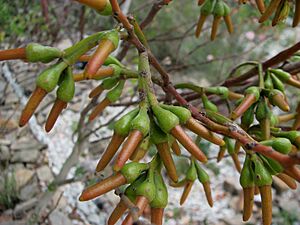Sand mallet facts for kids
Quick facts for kids Sand mallet |
|
|---|---|
 |
|
| Eucalyptus eremophila growing near Hyden | |
| Scientific classification | |
| Genus: |
Eucalyptus
|
| Species: |
eremophila
|
| Synonyms | |
|
Eucalyptus occidentalis var. eremophila Diels |
|
The Eucalyptus eremophila, often called the sand mallet or tall sand mallee, is a special type of tree or shrub. It is found only in the dry areas of Western Australia. This plant has smooth, light brown and grey bark. Its adult leaves are long and narrow, or oval-shaped. The flowers grow in groups, and the fruit looks like a cup or barrel.
Contents
What is a Sand Mallet?
The sand mallet is a type of mallet, which means it's a small tree or large shrub that doesn't have a woody swelling at its base (called a lignotuber). It usually grows to be about 2 to 8 meters (6.5 to 26 feet) tall. It can also spread out 4 to 8 meters (13 to 26 feet wide).
Appearance of the Sand Mallet
The bark of the sand mallet is smooth and shiny. It is light brown to grey and peels off in late summer. Young plants have glossy green leaves that are lance-shaped or oblong. These leaves are about 30 to 90 mm (1.2 to 3.5 inches) long.
Adult leaves are narrow and lance-shaped or elliptical. They are 45 to 110 mm (1.8 to 4.3 inches) long. Each leaf has a stalk, called a petiole, that is 5 to 18 mm (0.2 to 0.7 inches) long.
Flowers and Fruit
The flower buds grow in groups of seven, nine, or eleven. They are found where the leaf meets the stem (called a leaf axil). Each group of buds sits on a flat stalk, called a peduncle, which is 15 to 40 mm (0.6 to 1.6 inches) long. Each individual bud has a smaller stalk, called a pedicel, that is 4 to 11 mm (0.16 to 0.43 inches) long.
Mature buds are quite long, about 22 to 38 mm (0.9 to 1.5 inches). They are curved and spindle-shaped, with a long, horn-shaped cap called an operculum. The sand mallet flowers from August to December. Its flowers are usually lemon yellow, but sometimes they can be pale pink.
After flowering, the plant produces woody fruit. These fruits are shaped like a cup or a barrel. They are 8 to 14 mm (0.3 to 0.6 inches) long and 6 to 12 mm (0.2 to 0.5 inches) wide. The fruit hangs downwards on its pedicel.
How it Got its Name
The sand mallet was first officially described in 1904 by a scientist named Ludwig Diels. He found the plant near Boorabbin in the Coolgardie area. At first, he called it Eucalyptus occidentalis var. eremophila.
Later, in 1920, another scientist named Joseph Maiden decided that this plant was different enough to be its own species. So, he changed its name to Eucalyptus eremophila.
Meaning of the Name
The second part of the name, eremophila, comes from two Greek words. Eremi- means "desert," and philos means "lover." So, eremophila means "desert lover," which makes sense because this plant grows in dry, desert-like areas.
Where the Sand Mallet Grows
The Eucalyptus eremophila is found in the Wheatbelt and Goldfields-Esperance regions of Western Australia. It grows on rolling plains, hills, and sand dunes. It prefers sandy soils that are thin and lie over granite rock.
You can find it as far north-west as Quairading. It also grows all the way to the western edge of the Nullarbor Plain in the south-east.
Conservation Status
The Western Australian Government's Department of Parks and Wildlife has classified the sand mallet as "not threatened." This means it is not currently in danger of disappearing.
Uses of the Sand Mallet
The sand mallet is sold by plant nurseries as an ornamental plant. This means people buy it to make their gardens look nice.
It is also used for other important purposes:
- Erosion Control: Its roots help hold the soil in place, stopping it from washing away.
- Windbreak: It can be planted in rows to protect other plants or buildings from strong winds.
- Shade: It provides shade in wide areas like parks or nature strips.
This plant is quite tough and easy to grow. It likes to be in full sunlight. It can handle dry conditions (it's drought tolerant) and can survive a moderate frost. It grows well in neutral to acidic soils and can even be planted in areas near the coast. The sand mallet is also good for wildlife, as its flowers attract birds with their nectar. Its seeds are easy to grow.
See also
 In Spanish: Eucalyptus eremophila para niños
In Spanish: Eucalyptus eremophila para niños



